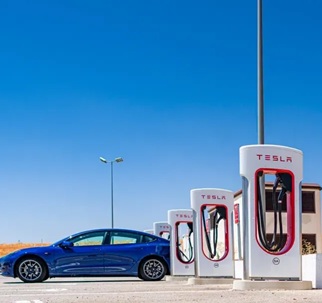


Tesla Superchargers Open to Non-Tesla EVs: What You Need to Know
LiCB Charge, a leading EV charger manufacturer in China, delivers reliable AC and DC electric vehicle charging stations along with comprehensive charging solutions.
Tesla operates one of the world’s largest and fastest EV charging networks. In the UK alone, there are over 40,000 Tesla Destination Chargers and more than 1,100 rapid Superchargers. Historically, these Superchargers were exclusive to Tesla vehicles — but since May 2022, Tesla has begun opening select Superchargers to non-Tesla electric vehicles (EVs).
If your EV supports the CCS (Combined Charging System) connector, the standard on most modern EVs, you can now use Tesla’s Superchargers by using the Tesla mobile app. Let’s explore how this works and what it means for EV drivers.
Tesla’s move is strategic and influenced by regulations and business goals:
Government Funding: The 2021 U.S. Bipartisan Infrastructure Law allocates $7.5 billion to expand EV charging. A key rule requires chargers to be accessible to all EV brands. To qualify, Tesla committed to opening parts of its Supercharger network to non-Tesla EVs by 2024.
Revenue Growth: Supercharging is mostly paid now. Opening the network to more EVs creates additional income beyond car sales.
Accelerating EV Adoption: Tesla aims to accelerate the world’s transition to sustainable energy. Opening the network helps reduce “range anxiety” and encourages wider EV adoption.
These Level 2 chargers are found at hotels, restaurants, and retail centers. Any EV with a Type 2 connector (standard in the UK and Europe) can use them. Type 1 connector EVs need an adapter.
Ultra-fast DC chargers that add up to 200 miles of range in about 15 minutes. Non-Tesla EVs must have a CCS connector to use these. The Tesla app is required to start, monitor, and stop charging. Not all Superchargers accept non-Tesla vehicles yet, so check the app.
Download the Tesla App: Use it to find compatible Superchargers, start/stop sessions, pay, and monitor charging.
Check Station Compatibility: Not all Superchargers allow non-Tesla EVs yet; find open stations via the app.
Compare Prices: Charging rates vary by location and time — check the app for the best deals.
Bring Adapters If Needed: Mainly for Destination Chargers; Superchargers require CCS connectors for non-Tesla cars.
Charging speed depends on your EV’s maximum DC fast-charge capability, battery condition, temperature, and charger load. Tests with vehicles like Ford Mustang Mach-E show Tesla Superchargers offer speeds comparable to other top fast chargers (e.g., IONITY). Many non-Tesla EVs can add up to 200 miles of range in about 15 minutes if supported by their battery.
Tesla uses its own North American Charging Standard (NACS) plug in the U.S. and Canada, limiting Supercharger use to Tesla cars historically. However, automakers like Ford and GM plan to adopt NACS starting in 2025, and Tesla offers adapters for CCS vehicles in the meantime, paving the way for broader access.
More Charging Locations: Access Tesla’s reliable, widespread network.
Better Reliability: Tesla stations have high uptime and fast charging.
Industry Progress: Moves toward unified charging standards benefit all users.
Not all Superchargers allow non-Tesla EVs yet.
Tesla cables are designed for Tesla cars; some non-Tesla EVs may need creative parking.
Pricing may be higher for non-Tesla users.
Early software glitches may occur — keep apps updated.
Tesla’s opening of its network marks a major step toward a more accessible, unified EV charging future. As automakers adopt Tesla’s standards, charging will become easier and faster for everyone.
If your EV has a CCS connector (Europe/UK) or a NACS adapter (North America), you could already charge at Tesla Superchargers. Tesla Destination Chargers also offer broad compatibility with the right plugs. This change means more charging options and a smoother EV experience for all drivers.Learn more about Google SEO.
